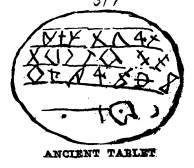Ohio History Journal
Editorialana. 261
plained. Indeed the annotations
themselves have a value second only to
the text which they explain. They
constitute a compendium of informa-
tion that evidences the faithfulness and
enthusiasm with which Mr. Con-
nelley has performed his work. We cite
only one instance especially
interesting to Ohio readers. It is Mr.
Connelley's note on the meaning
of the word "Ohio." He says: "Ohio is derived from the Iroquois.
The original is variously spoken in the
different dialects. In Wyandot
it is Ohezhu; in Mohawk and Cayuga it is
oheyo; in Onondaga and
Tuscarora it is Oheye; in Oneida it is
Ohe; in Seneca it is very nearly
the same as in Wyandot. Darlington, in
his Christopher Gist's Journals,
p. 94, and Morgan in his League of the
Iroquois, say this means 'fair,'
'beautiful,' and that the Iroquois
called the Ohio the Beautiful River.
The French so called it (La Belle
Riviere), but there is no evidence
that they secured the name from any
Indian original. The word does
not mean 'fair,' neither does it mean
'beautiful.' It means great. The
Iroquois, therefore, called the Ohio the
Great River. The Wyandots
call it Ohezhu Yandawaye--Great River.
And in the various dialects
of the Iroquois it is so called without
exception. They give the stream
that name from it source to the Gulf of
Mexico; with them it is the
main stream and has but one name. When I
became acquainted with
the Wyandots they told me of hunting
trips to the 'Sunken Lands' on
the Ohio. 'But,' I replied, 'there are
no sunken lands on the Ohio.'
'Yes,' they said, 'plenty on Ohio;
plenty by New Madrid.' 'But New
Madrid is on the Mississippi,' I
insisted. 'We call him Ohio-all along,
Ohio; not call him Mississippi any
place.' The Iroquois must have had
at some time a name for the Mississippi
above the mouth of the Ohio,
but those I have met do not remember
it."
GRAVE CREEK MOUND.
[One of the most interesting and noted
mounds of the West is the one
located at Moundsville, W. Va. It was
recently reported that the proprietor
had offered it for sale to any
historical society and that in default of a purchaser
he would destroy it, in order to have
the use of the grounds for agricultural
purposes. It appears, however, that the
West Virginia legislature laudably came
to the rescue and secured the property
for preservation. The following interesting
history of this mound and its
explorations is from the pen of Mr. Wills De Haas.
The article appeared in a late number of
The Philadelphia Ledger. We repro-
duce it in full with an accompanying cut
of the famous ancient tablet found in
the mound.-EDITOR.]
The Legislature of West Virginia at its
late session did a praise-
worthy act in purchasing the great mound
at Moundsville, one of the
largest and most interesting prehistoric
tumuli in central North America.
This important mound has long interested
scholars and antiquarians, and
has also provoked controversy. A
description and a statement of the
controversy may not be uninteresting at
this time. The tumulus is a
typical structure of the Mound
period--conical, symmetrical and 70 feet
